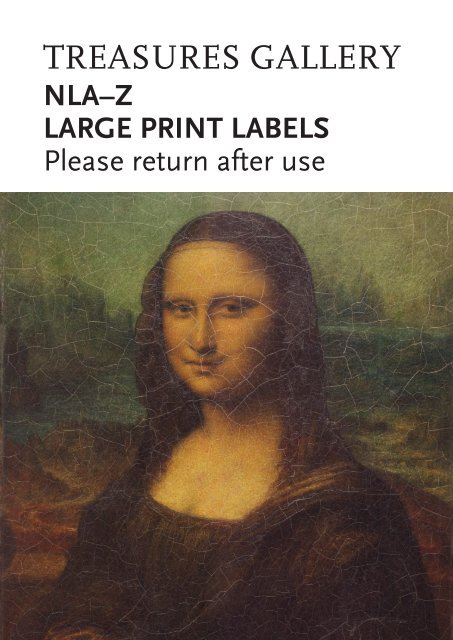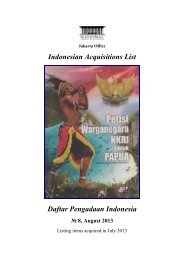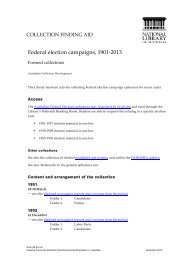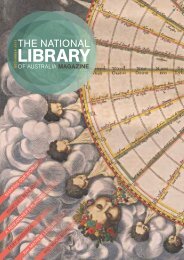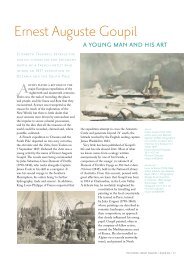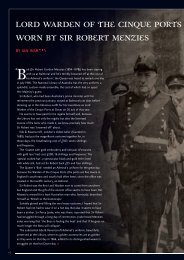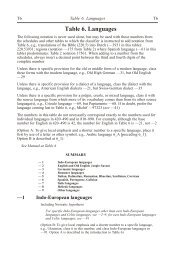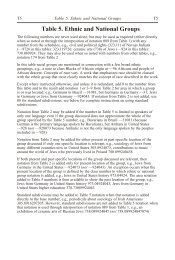Large Print Labels - NLA-Z - National Library of Australia
Large Print Labels - NLA-Z - National Library of Australia
Large Print Labels - NLA-Z - National Library of Australia
You also want an ePaper? Increase the reach of your titles
YUMPU automatically turns print PDFs into web optimized ePapers that Google loves.
TREASURES GALLERY<br />
<strong>NLA</strong>–Z<br />
LARGE PRINT LABELS<br />
Please return after use
COVER<br />
MORTIMER MENPES (1855 – 1938)<br />
La Giaconda (detail) between 1900 and 1909<br />
MORTIMER MENPES COLLECTION OF REPRODUCTIONS OF THE GREAT MASTERS (PICTURES)
MAP<br />
TERRA AUSTRALIS<br />
TO AUSTRALIA<br />
REALIA<br />
<strong>NLA</strong>-Z<br />
entry<br />
exit
A<br />
EDWARD STANFORD LTD, London<br />
Atlas <strong>of</strong> the British Empire: Reproduced from the Original Made<br />
for Her Majesty Queen Mary’s Doll’s House 1925<br />
MAPS COLLECTION<br />
A is for Atlas<br />
This atlas is one <strong>of</strong> the smallest in the world. The original was<br />
created as part <strong>of</strong> the doll’s house given to Queen Mary in 1924.<br />
At a scale <strong>of</strong> 1 inch to 1 foot, the house and its contents were<br />
produced by leading craftsmen, artists, writers and companies<br />
<strong>of</strong> the time. Made by King George V’s cartographers, the atlas<br />
features 12 maps, with the colonies <strong>of</strong> the British Empire coloured<br />
in red.
B<br />
MILES COVERDALE (1488–1569)<br />
The Whole Byble, that Is the Holy Scripture <strong>of</strong> the Olde<br />
and Newe Testament<br />
Zurich: Christopher Froschover for Andrewe Hester, 1550<br />
(2 nd edition)<br />
OVERSEAS RARE BOOKS COLLECTION<br />
B is for Bible<br />
This is a rare second edition <strong>of</strong> the Coverdale Bible, the first full<br />
English translation. Prior to the first edition <strong>of</strong> 1535, only parts <strong>of</strong> the<br />
Bible had appeared in English. Coverdale’s version is known for the<br />
psalms and for including the Apocrypha, a collection <strong>of</strong> controversial<br />
texts widely known in early modern Europe, as an appendix to the<br />
Old Testament. The stories <strong>of</strong> Susanna and the Elders and <strong>of</strong> Judith<br />
and Hol<strong>of</strong>ernes, for example, inspired countless artists.
C<br />
GEOFF PRYOR (b. 1944)<br />
Let’s Hear it for Librarians! 2002<br />
PRYOR COLLECTION OF CARTOONS AND DRAWINGS (PICTURES)<br />
C is for Cartoon<br />
Ge<strong>of</strong>f Pryor is an award-winning <strong>Australia</strong>n political cartoonist<br />
who has worked for The Canberra Times since 1977. His cartoons<br />
were first published in the <strong>Australia</strong>n <strong>National</strong> University’s<br />
student magazine, Woroni. This cartoon was featured in The<br />
Canberra Times on 1 April 2002. In 2003, Pryor began donating<br />
many <strong>of</strong> his original works to the <strong>Library</strong>, a collection which today<br />
numbers over 7,000 cartoons.
D<br />
WILLIAM HARDY WILSON (1881–1955)<br />
Dorking, Britain, China, Kurrajong 1953<br />
PICTURES COLLECTION<br />
D is for Dorking Chicken<br />
The Dorking chicken was introduced into Britain by the<br />
Romans in AD 30, making it one <strong>of</strong> the oldest breeds <strong>of</strong> poultry<br />
domesticated for human use. Wilson was an influential <strong>Australia</strong>n<br />
architect and artist, best known for his drawings <strong>of</strong> <strong>Australia</strong>n<br />
colonial architecture. This work is part <strong>of</strong> the series, Fowls <strong>of</strong><br />
the World, created for the 12 interior pilaster capitals <strong>of</strong> Wilson’s<br />
radical design for the ideal city <strong>of</strong> Kurrajong.
E<br />
Ethiopian Healing Scroll late 1800s<br />
MANUSCRIPTS COLLECTION<br />
E is for Ethiopian Healing Scroll<br />
Ethiopian healing scrolls contain prayers and images for<br />
protection, healing or blessing. Prepared by Coptic Christian<br />
clerics, each scroll is measured to the height <strong>of</strong> its owner, thereby<br />
protecting that person from head to toe. Made from goat or calf<br />
skin worked into vellum, the scrolls are written using natural<br />
vegetable dye. The language is Ge’ez, which is no longer spoken<br />
and appears only in religious texts.
F<br />
IDA RENTOUL OUTHWAITE (1888–1960)<br />
Cocktails in the Bush c. 1927<br />
PICTURES COLLECTION<br />
F is for Fairy<br />
Best known for the ethereal beauty <strong>of</strong> her elves and fairies,<br />
Rentoul Outhwaite was among the most successful early<br />
20th-century <strong>Australia</strong>n children’s book illustrators. In many<br />
works, she blends European and <strong>Australia</strong>n motifs. This<br />
watercolour is a wry commentary on the contentious 6 pm<br />
closing time <strong>of</strong> pubs. To the right, beneath a kookaburra, the<br />
clock reads 6.05 pm. The koalas are still drinking, however,<br />
and the fairy is still serving cocktails. An elvish policeman lurks<br />
among the toadstools, ready to enforce the law.
G<br />
Shoka han’ei sugoroku between 1869 and 1900<br />
ASIAN COLLECTION<br />
G is for Game<br />
Sugoroku (‘double sixes’) is a Japanese board game similar to<br />
snakes and ladders. Its popularity peaked in the 19th century,<br />
when the woodblock print industry was flourishing. Although<br />
it was produced for recreation, the sugoroku board was also<br />
an efficient tool for conveying information and was used in<br />
education, advertising or to promote nationalist sentiment. This<br />
sugoroku contains advertisements for various shops in the centre<br />
<strong>of</strong> Tokyo during the early Meiji period.
H<br />
CARL LINNAEUS (author, 1707–1778)<br />
Hortus Cliffortianus (Clifford’s Garden)<br />
Amsterdam: 1737<br />
REx NAN KIVELL COLLECTION (PICTURES)<br />
H is for Herbarium<br />
Anglo-Dutch merchant George Clifford (1685–1760) cultivated a<br />
magnificent garden and herbarium—a systematic collection <strong>of</strong><br />
dried plants—at his estate in the Netherlands, the Hartekamp.<br />
In 1735, he employed young Swedish doctor and botanist Carl<br />
Linnaeus to organise his collections and write this catalogue.<br />
It proved a fruitful relationship. Linnaeus was ‘bewitched’ by<br />
Clifford’s hothouses and his work at the Hartekamp became<br />
the foundation for his renowned work <strong>of</strong> classification, Species<br />
Plantarum (1753). This plate depicts ‘simple leaves’.
I<br />
A.J. CUMMING, GOVERNMENT PRINTER, Brisbane<br />
Invitation to a Banquet Given by the Government <strong>of</strong> Queensland<br />
for His Royal Highness the Prince <strong>of</strong> Wales on 28 July 1920<br />
EPHEMERA COLLECTION<br />
I is for Invitation<br />
The <strong>Library</strong>’s Ephemera Collection includes invitations <strong>of</strong> all<br />
shapes and sizes for a wide variety <strong>of</strong> occasions. This example<br />
is for a banquet honouring the popular Prince <strong>of</strong> Wales, who<br />
later married Wallis Simpson, during a tour <strong>of</strong> <strong>Australia</strong> to<br />
thank the nation for its contribution to the First World War. The<br />
Prince spent about four days in Brisbane, where he opened the<br />
Exhibition, or Ekka. The banquet was catered by Finney’s Cafe,<br />
the restaurant <strong>of</strong> a Brisbane department store.
J<br />
PETER SCULTHORPE (b. 1929)<br />
It’s Blossom Time, Words and Music by<br />
P.J. Sculthorpe, Op. 4 No. 3 c. 1943<br />
PAPERS OF PETER SCULTHORPE (MANUSCRIPTS)<br />
J is for Juvenilia<br />
Juvenilia is defined as literary, musical or artistic works produced<br />
by authors, artists or composers in their youth. This manuscript<br />
<strong>of</strong> a song by renowned <strong>Australia</strong>n composer Peter Sculthorpe was<br />
written when he was about 14 years old. He began composing<br />
from the age <strong>of</strong> seven, much to the dismay <strong>of</strong> his piano teacher,<br />
who preferred him to practice other people’s works rather than<br />
compose his own. Today, Sculthorpe has composed over 380<br />
works, including orchestral and chamber music.
K<br />
ROBERT DESNOS (author, 1900–1945)<br />
Thirty Sung Stories for Good Children to Sing to Any Tune<br />
Paris: Librairie Gründ, 1944<br />
AUSTRALIAN RARE BOOKS COLLECTION<br />
RECENT ACQUISITION<br />
K is for King <strong>of</strong> Kangaroos<br />
Kangaroo the first, king <strong>of</strong> Kangaroos<br />
Having hung up his big sword on the nail<br />
Sits on a throne <strong>of</strong> cabbage leaves<br />
This book <strong>of</strong> animal nonsense rhymes is one <strong>of</strong> the lightest works<br />
by French surrealist poet Robert Desnos, a member <strong>of</strong> the French<br />
Resistance during the Second World War. It was published just<br />
weeks before he was deported to the first in a series <strong>of</strong> Nazi<br />
concentration camps, including Auschwitz.
L<br />
LIONEL LINDSAY (1874–1961)<br />
clockwise, from top left<br />
Bookplates for John Ferguson (1914), Keith Murdoch (1944),<br />
Will Ashton (1950) and Robert Menzies (1940)<br />
PICTURES COLLECTION<br />
L is for Lionel Lindsay<br />
Part <strong>of</strong> the famous Lindsay family, the celebrated and prolific<br />
artist Lionel Lindsay worked as a painter, printmaker, cartoonist,<br />
illustrator and writer. Between 1911 and 1958, he produced at<br />
least 60 bookplates, giving the majority as gifts rather than<br />
accepting commissions. Pasted inside the cover <strong>of</strong> a book to<br />
indicate ownership, a bookplate is usually visually symbolic <strong>of</strong><br />
the owner. The Latin phrase ex libris means ‘from the books’,<br />
indicating the publication is ‘from the library’, <strong>of</strong> the owner.
M<br />
MORTIMER MENPES (1855–1938)<br />
La Gioconda between 1900 and 1909<br />
MORTIMER MENPES COLLECTION OF REPRODUCTIONS OF THE GREAT MASTERS (PICTURES)<br />
M is for Mortimer Menpes’ Mona Lisa<br />
This copy <strong>of</strong> Leonardo da Vinci’s Mona Lisa is one <strong>of</strong> 38 copies<br />
<strong>of</strong> great masterpieces painted by Adelaide-born artist Mortimer<br />
Menpes in the <strong>Library</strong>’s collection. The works were donated<br />
to the <strong>Australia</strong>n Government in 1911, in the hope they would<br />
form the foundation <strong>of</strong> a national collection. Menpes moved to<br />
London at the age <strong>of</strong> 20 to pursue a career as an artist, studying<br />
under the great American painter, James Whistler.
N<br />
The Fiji Observer and West Pacific Advertiser<br />
no. 55, Friday 15 July 1887<br />
OVERSEAS RARE BOOKS COLLECTION<br />
N is for Newspaper<br />
The increase in European settlement <strong>of</strong> Fiji during the late<br />
19th century led to the establishment <strong>of</strong> the first English-language<br />
newspapers. This rare edition <strong>of</strong> The Fiji Observer and West Pacific<br />
Advertiser is printed on tapa, which is made from thin strips <strong>of</strong><br />
bark. Tapa plays an important ceremonial role in South Pacific<br />
cultures and is used to make everyday clothing and decorations.
O<br />
JOHN GOULD (publisher, 1804–1881)<br />
ELIZABETH GOULD (illustrator, 1804–1841)<br />
A Century <strong>of</strong> Birds from the Himalaya Mountains<br />
London: John Gould, 1832<br />
MATHEWS COLLECTION (AUSTRALIAN RARE BOOKS)<br />
O is for Ornithology<br />
Englishman John Gould’s name is synonymous with ornithology,<br />
or the study <strong>of</strong> birds. This is his first book. In around 1830,<br />
Gould, then a private taxidermist and Curator and Preserver at<br />
the Zoological Society <strong>of</strong> London, had access to a large number<br />
<strong>of</strong> Himalayan bird skins. He writes: ‘India ... presents a field the<br />
richness <strong>of</strong> whose stores at once invites and repays the industry<br />
<strong>of</strong> the naturalist’. Gould’s wife, Elizabeth, produced the exquisite<br />
hand-coloured lithographs.
P<br />
GORDON CLIVE BLEECK (author, 1907–1971)<br />
MAURICE BRAMLEY (artist, 1898–1975)<br />
Cover Pro<strong>of</strong>s for Master-mind Menace<br />
and Depths <strong>of</strong> Death c. 1950<br />
G.C. BLEECK COLLECTION (PICTURES)<br />
P is for Pulp Fiction<br />
The <strong>Library</strong>’s G.C. Bleeck Collection is populated with<br />
private dicks, dangerous dames, mind-controlling Martians<br />
and brain-eating zombies. Bleeck wrote and collected pulp<br />
fiction—mass-produced novels, in which the emphasis is on<br />
generic conventions rather than high-brow literary merit. In the<br />
1940s and 1950s, the <strong>Australia</strong>n ban on American paperbacks<br />
helped the domestic pulp industry to thrive. Bleeck wrote many<br />
<strong>of</strong> these works under the pseudonym Belli Luigi.
Q<br />
Qur’an<br />
Persia: between c. 1850 and 1899<br />
MANUSCRIPTS COLLECTION<br />
Q is for Qur’an<br />
This beautifully illuminated Persian manuscript contains a<br />
complete version <strong>of</strong> the holy book <strong>of</strong> Islam, the Qur’an, in Arabic<br />
script. On the right-hand page is the opening verse, Al Fatihah,<br />
a prayer that Muslims are required to know by heart and recite<br />
during daily prayer. On the left-hand page is the beginning <strong>of</strong> the<br />
Al Baqarah, the longest verse in the holy book. This manuscript<br />
most likely dates from the mid- to late Qajar dynasty, which ruled<br />
Persia from 1794 until 1925.
R<br />
after WILHELM GOTTLIEB TILESIUS VON TILENAU<br />
(artist, 1769–1857)<br />
IVAN FEDOROVICH KRUSENSTERN<br />
(author, 1770–1846)<br />
An Inhabitant <strong>of</strong> the Island <strong>of</strong> Nukahiva<br />
in Journey around the World in the Years 1803, 1804, 1805, and 1806<br />
Saint Petersburg: Morskaia Tipografiia, 1809–1813<br />
MAPS COLLECTION<br />
A BICENTENNIAL GIFT FROM THE MINNAMURRA FOUNDATION, 1988<br />
R is for Round the World<br />
Between 1803 and 1806, under the patronage <strong>of</strong> Tsar Alexander I,<br />
Krusenstern completed the first Russian circumnavigation <strong>of</strong> the<br />
world. His report <strong>of</strong> the voyage was illustrated in this volume by<br />
Tilesius von Tilenau, who served as ship’s doctor, marine biologist<br />
and expedition artist.
S<br />
WALTER CHARLETON (1619–1707)<br />
Chorea gigantum (The Giants’ Dance)<br />
London: Henry Herringman, 1663<br />
DAVID NICHOL SMITH COLLECTION (OVERSEAS RARE BOOKS)<br />
S is for Stonehenge<br />
Debate over the meaning and origin <strong>of</strong> Stonehenge, the circle <strong>of</strong><br />
ancient megalithic - shaped stones on Salisbury Plain in Wiltshire,<br />
England, raged even in the 17th century. This is one <strong>of</strong> the earliest<br />
books to discuss its meaning. Charleton was physician-in-ordinary<br />
to English King Charles II and a founding fellow <strong>of</strong> the Royal Society.<br />
In what he calls his ‘laborious Enquiry’, Charleton argues that<br />
Stonehenge is an ancient Danish Royal Court. He critiques the<br />
work <strong>of</strong> earlier authors Inigo Jones, who had argued it was a Roman<br />
temple, and William Camden.
T<br />
LOUDON SAINTHILL (1919–1969)<br />
A Tree Creature, The Tempest 1951<br />
PICTURES COLLECTION<br />
RECENT ACQUISITION<br />
T is for Tree Creature<br />
This costume design by <strong>Australia</strong>n artist and designer Loudon<br />
Sainthill was for a production <strong>of</strong> Shakespeare’s The Tempest at<br />
the Shakespeare Memorial Theatre, Stratford-on-Avon, England,<br />
in May 1951. In the play, the Tree Creature is imprisoned inside a<br />
tree and left to die by the sorceress, Sycorax. Freed by Prospero,<br />
the exiled Duke <strong>of</strong> Milan, the Tree Creature appears torn from<br />
nature, sprouting roots and galls on his skin, his hair horned and<br />
curled into a gnarled crown.
U<br />
GOODIE REEVE (music and lyrics, 1898–1978) for<br />
CLIFFORD, LOVE AND CO., Sydney<br />
Eat Your Uncle Toby’s Every Day<br />
Sydney: <strong>Print</strong>ed by Clifford Love and Co., c. 1935<br />
MUSIC COLLECTION<br />
U is for Uncle Toby’s<br />
Uncle Toby’s, an <strong>Australia</strong>n brand <strong>of</strong> breakfast cereals, was<br />
named in 1893 after a character in Laurence Sterne’s classic<br />
English novel The Life and Times <strong>of</strong> Tristram Shandy (1759). This<br />
sheet music is for an Uncle Toby’s jingle in the 1930s, when<br />
singing commercials were very much a part <strong>of</strong> the new live radio<br />
experience. The lyrics promise that if you eat the company’s oats<br />
you’ll ‘grow up big and strong’.
V<br />
LOUIS PASTEUR (1822–1895)<br />
Letter to Mrs Priestley 30 December 1887<br />
MANUSCRIPTS COLLECTION<br />
V is for Vaccination<br />
Regarded as the father <strong>of</strong> modern microbiology, French scientist<br />
Louis Pasteur discovered vaccines for rabies and anthrax. In this<br />
letter addressed to Lady Eliza Priestley, an English campaigner<br />
for preventative medicine, he discusses his successful field<br />
experiments in eradicating rabbits using the micro-organisms<br />
responsible for chicken cholera. Pasteur hoped to win a New<br />
South Wales government contest to eliminate the rabbit plague in<br />
<strong>Australia</strong> and New Zealand. The prize was worth £25,000—around<br />
$10 million today.
W<br />
THE WIGGLES (music and lyrics)<br />
GRAHAM JESSE (arrangement)<br />
Shake Your Sillies out 1994<br />
GEOFF HARVEY COLLECTION OF MUSIC ARRANGED FOR AUSTRALIAN<br />
TELEVISION 1960–1998 (MUSIC)<br />
RECENT ACQUISITION<br />
W is for the Wiggles<br />
Famous for their trademark coloured skivvies, catchy tunes and<br />
energetic stage shows, <strong>Australia</strong>n children’s entertainers the<br />
Wiggles are one <strong>of</strong> the world’s most successful musical acts. They<br />
have sold more than 23 million DVDs and seven million CDs and<br />
their television program is broadcast in over 100 countries. This<br />
handwritten score is from a live performance by the Wiggles on<br />
Channel Nine’s Midday Show on 27 June 1994.
X<br />
LUDWIG SCHMIDT (engraver)<br />
AFTER ANDREAS KRUGER (artist, 1743–1805)<br />
MARCUS BLOCH (author and publisher, 1723–1799)<br />
Xiphias gladius plate 76 from Ichthyology, or Natural History,<br />
General and Particular Fish<br />
Paris and Berlin: Marcus Bloch, 1795–1797<br />
REx NAN KIVELL COLLECTION (PICTURES)<br />
X is for Xiphias gladius, the Swordfish<br />
The swordfish’s taxonomic name is derived from the Greek<br />
xiphias and the Latin gladius, both <strong>of</strong> which mean ‘sword’. This<br />
plate is from a book regarded as the greatest work on fish<br />
published in the 18th century.
Y<br />
QUALITY GAMES PTY LTD<br />
Sydney to Hobart Yacht Race Game c. 1962<br />
MAPS COLLECTION<br />
Y is for Yacht Race<br />
An annual <strong>Australia</strong>n event, the Sydney to Hobart Yacht Race<br />
commences on Boxing Day, 26 December. This rare board game<br />
is a simple roll and move game for two to four players, set on a<br />
grid <strong>of</strong> squares representing the geographic path <strong>of</strong> the race. The<br />
word ‘yacht’ originated in the 17th century from the Dutch Jacht,<br />
meaning ‘hunt’.
Z<br />
Drop Mail Pouch and Tail from<br />
LZ 127 Graf Zeppelin 1934<br />
Photograph <strong>of</strong> Mail Parachute being Dropped by<br />
LZ 129 Hindenburg 1937<br />
CROME COLLECTION (PICTURES)<br />
Z is for Zeppelin Mail<br />
From 1908 to 1939, zeppelins, or German airships, carried<br />
mail across the Atlantic. The postmarks and stamps were highly<br />
prized by collectors and revenue from postage financed much <strong>of</strong><br />
the operating cost. This water-resistant mail pouch from the<br />
Graf Zeppelin has instructions in four languages for the finder:<br />
‘Please deliver the contents <strong>of</strong> this postbag immediately to the<br />
next post <strong>of</strong>fice’. Attached to the pouch is a long cloth tail to<br />
increase its visibility.


